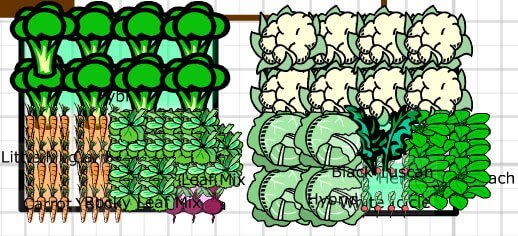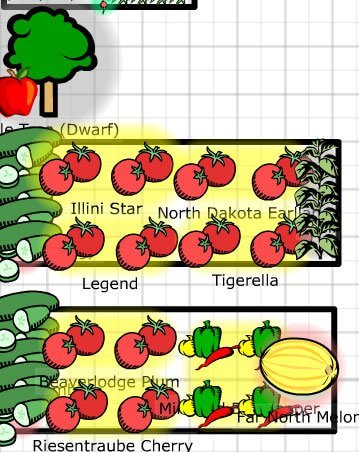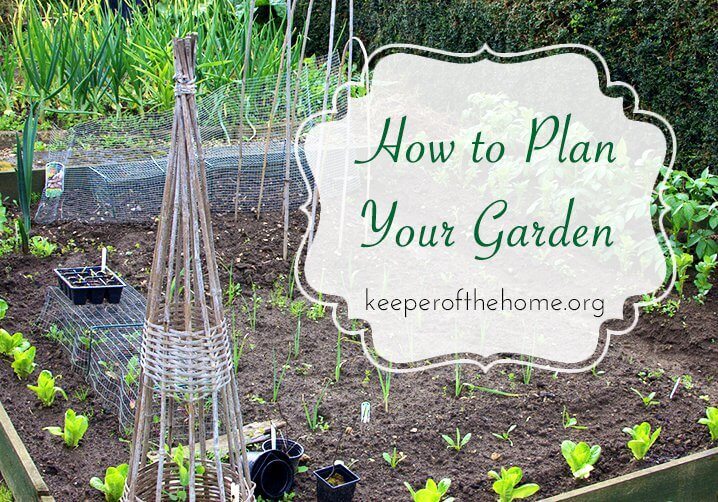How to Plan Your Garden
This post was originally published in March of 2011, but we’re sharing it today because it’s gardening season once again! Use these tips to plan your own garden and discover how fun and easy it can be to grow your own food!
In our Gardening 101 series, we’ve talked about a lot of different things so far… how to select seeds for better success, growing herbs, gardening based on where you live, square foot gardening.
I know that the process of planning what and how much and when and where to plant everything can be one of the most daunting aspects of gardening. It’s a place where a lot of people get stuck. They’ve got an idea of things they’d like to grow, they know where the garden will be, they’ve bought some seeds, but now what?
In this two part series, I’m going to walk you through the process of planning out an actual garden— my own. I’m going to show you the steps I take, how I make my decisions, what the plans look like, and how those plans translate into simple steps that I can follow through with.
It’s all about taking theories and concepts, and turning them into vegetables on your plate. Sounds good, right?
Step 1: What do you want to grow?
Based upon my family’s preferences and foods that I like to preserve, these are the foods I most want to grow, listed in order of priority:

Your list might look quite different, but from #1-19, these are the veggies that matter to me most (I know, I’m not exactly a minimalist, am I?). I’ll tell you right now that I don’t have as much space in my garden as I have veggies on my wishlist. So I make compromises, but I’ll get to that in a little while.
For now, make a list of the veggies that most matter to you (or fruit, if that’s something you want in your garden- I grow just a few things, like some raspberry canes and a rhubarb plant). Do it based on what your family eats the most, on what costs the most where you live, on vegetables that you want to buy organic but can’t afford (the Dirty Dozen comes in handy here), on the things that you think taste the best when they’re garden fresh, etc.

Step 2: How much do you want to grow?
Personally, I like to grow enough to eat freely throughout the harvest season, with as much extra for preserving as possible. At this point, with only a small-ish backyard garden, I certainly don’t expect to put up nearly enough food to keep us going through the winter (though it is surprising how much can be grown in a small space).
There are a lot of charts out there that tell you how much you need to grow to feed a family of 4. They’re usually based on rows, which I don’t find very helpful (although some do show how many plants per row, and the yield, which is slightly more useful).
I find the info in the book Square Foot Gardening gives a good general guide for determining how much room I need. He writes about how many 4×4 ft blocks (or 16 square feet) you need to feed fresh produce to 2 people (2-4 blocks, depending how much you eat and the variety you want), 4 people (4-6 blocks), and then additional space for preserving.
I have 86.5 sq ft in raised beds, another 38 sq ft in the ground, a garbage can for my potatoes and a bunch of containers for my raspberries. My 130+ square feet equals about 8 4×4 ft blocks. According to the Square Foot calculations I should be able to grow enough to feed us well during harvest months, plus have some to preserve. I would agree that the space I have will allow us to do just that.

Ultimately, I find that it’s easiest to just guesstimate how much our family eats and plan to plant in accord with those numbers. Here are some of my own examples:
- Cucumbers (slicing)- 2-3 large or 5-6 small per week
- Tomatoes- 6-8 small or 3-5 large per week, and a bowlful of cherry toms
- Zucchini- 1-4 per week (totally depends how we’re using them)
- Carrots- 5-10 per week (depends on size, if they’re baby ones we’ll eat way more)
With this in mind, here’s what I might plan:
- Cucumbers (slicing)- 5-6 plants (they grow slowly where we live, but if you live somewhere hot you might need a couple less plants for the same yield)
- Tomatoes- 2-3 regular plants, plus a cherry tomato plant
- Zucchini- 1 plant is probably enough (because they reproduce just like bunnies 🙂
- Carrots- We start harvesting them around June/July, so I’ll plant 8 carrots for each week of the summer from that point on. If I planted 112, that would do us through about 14 weeks of summer (mid-June to end of September). I would want to stagger my planting over 4-6 weeks so they’re not all ready at once.
Notice that I haven’t taken preserving into account yet. If I want to also preserve zucchini in addition to eating it fresh, for example, I will grow 2 plants instead of 1, so that I can shred and freeze a lot for the winter. I like to can and dehydrate about 60-100 lbs of tomatoes each summer, so I’ll want another 8-10 plants purely for preserving purposes.
Now your next step is to take your list from Step 1, and either based on your own gardening experience or these links, jot down beside each vegetable how much you might need to grow to get what you want.
;

Planning Your Own Garden
If you’re wondering how I made these awesome garden planning images, it’s this new site I just discovered called GrowVeg.com. Basically it is a garden planning software. You use it’s tools to draw up a map of your yard or garden, as close to scale as possible (you can be quite precise with it), and then you drag and drop the specific crops that you want to grow. You can pull them larger to make rows or blocks of the same crops, you can label them as specific varieties (like my 6 different tomato varieties), and all sorts of other customizations. It shows you the spacing that each plant needs, and give you sowing and harvest dates (which are based on weather stations near your home, so they’re fairly accurate).
I’m using their 30-day free trial at the moment (a one-year subscription is $25, 2 years is $40). I haven’t quite decided if I want to go ahead and subscribe but so far I’m pretty impressed, and I’ll show you more of how this can be a helpful tool in the next post. I am an affiliate, so if you go ahead and purchase through my links I make a small commission, which helps me to keep this site running (so thanks!).
In the next post, I’ll continue to walk you through translating those numbers of what you desire to grow and harvest into the space that you actually have available, and then some tips on how to arrange it all in a way that works.
What are your biggest challenges in planning your garden?
Other Related Posts You May Enjoy
- How to Plan Your Garden part two
- A Tale of Two Gardens part one and part two
- Organization in the Garden: Evaluating What You Have and What You Need
- Getting Organized in the Garden: Seed Starting and Planting Schedule
- Naturally Controlling Pests in the Organic Garden
- 5 Steps to Being a Lazy Gardener
- Gardening in Less-than-Ideal Spaces
- 7 Gardening Lessons from a Novice Gardener
- Selecting Seeds for Garden Success
- Gardening with Herbs 101: Where to Begin
- Gardening with Herbs 101: What To Grow
- How to Plant a Garden that Works for Where You Live
- 7 Reasons to Square Foot Garden
- Plan & Plant Now for Sustainability, Freedom, and a Backyard Revolution




I am planting my first garden this year and the biggest challenge for me is to keep it small so I don’t overwhelm myself…I keep thinking of new things I want to plant! I have a 4′ x 8′ raised bed (most planted, waiting for frost-free time to plant rest), but then I’m also going to plant beans and corn on the hill, and have tomatoes, herbs (lots!), tomatillos and two hot peppers on the deck. It’s so much fun seeing the plants starting to grow…my onions and garlic have sprouted!!
I love your blog…I have found so many useful articles–thank you for sharing it all!
I was wondering how you expect to contain your melon to such a small space? Will you be using wire trellis or something?
@John and Emma, I know it’s hard to tell in the picture but it’s 3 square feet that I’ve got it in. If it starts to need more room, I’m going to let it grow over the box and support it. Truth is, where I live melons don’t grow all that well, so I don’t need tons of space. To this point, I’ve never successfully grown a ripe melon (sad, but true). Yet, I keep on trying! 🙂
@Stephanie @ Keeper of the Home, I also live in a climate where melons do not grow very well, but I did have some success last year in my sf garden with cantaloupe/musk melon. Never got a watermelon, (I keep trying!) but several of the others!
@brook, That gives me hope to hear that you got something! I am also trying to grow a sugar baby watermelon, in addition to my Far North Melons (like a musk melon, I think).
This is exactly the information I have been trying to find! I’ve got all my seedlings started, have my plot tilled and have been adding organic fertilizers to it, but have not been able to find any information at all about where to plant things in the garden. Although I’m planning on planting 12 tomato plants, and I wasn’t planning on canning, so I think I might have overestimated how much I like tomatoes. 🙂 Thanks for the helpful info!
@Kate from Kinda Crunchy Kate blog, Good, I’m glad this was useful information! I’m sure 12 tomato plants would be very yummy, but you’ll definitely have enough for at least some preserving. 🙂
I was just wondering what you used for this–it is so neat to see.
I have also heard of ‘square foot gardening’ from a friend. In the last 3 years we’ve moved 3 times, and two of those 3 years will be participating in a CSA. My husband has grand plans of a garden but I’m finding it hard to really get into it (other than a few herb pots and scattering some wild flowers/butterfly flowers in the front of the house!) because I know we’ll be moving in a year again and it’s a lot of work! Someday, though, we WILL have a big garden again, but I do love to read about other people’s gardens and look at their plans.
Thanks for sharing,
Sarah M
@Sarah M, I totally get not wanting to jump in when you know you’re going to be moving. It’s only been in our last two homes that I’ve felt we would be there for any length of time, and even in our last one, I still only got 2 1/2 gardening seasons before I had to leave it. Sad. But I just can’t stop myself, so I plant anyways!
I have been gardening for a few years now and love it! I also make my list. Lettuce is high on my list because it is currently so expensive and can be grown so inexpensively!
One thing I like to base my veggie growing selection upon is the veggies my kids will snack on during the summer. Nothing makes me happier than seeing my kids snack directly out of the garden. They love to snack on fresh peas, green beans, broccoli, carrots and strawberries.
Another thing I like to take into consideration is the veggies my kids enjoy helping me harvest. They LOVE to dig for potato treasures! Beets are also fun and rewarding to pull out of the ground. I never have a hard time finding assistants for these tasks.
@Tanya, That’s neat how you consider what your children enjoy helping with! I also love to see my kids eating fresh veggies straight out of the garden. Now why won’t they do that out of the fridge? 🙂
We have been gardening for many, many years. This was a very excellent post. I linked to it my recent post.
Bunnies were a challenge for us last year. They kept nibbling on our strawberries. We are installing a raised bed this year so I would appreciate any info about natural animal deterrents.
@Emily @Random Recycling,
Emily, we use raised beds but bunnies can still hop into the bed if they are of a mind to do so. My husband built fences to go around the bed which keeps them out. He is redoing all of them this year, since they have broken down over the years. Basically, they are wooden frames with a mesh stapled to them so that animals cannot get through. (They could chew through, I suppose, but we’ve never had this problem thus far.) Each section rests on the side of the raised bed and has a post through the center that slips into drawer pull handles that are attached to the outside of the bed so that they can be easily removed to weed, harvest, etc.
Rabbits don’t like onions, so if you plant some onions here and there in your strawberry bed, that might help keep them away, too.
This is so timely and fabulous!! We’re having a garden for the first time this year since we’re not traveling as much this summer and I’m so excited about it! We’re building a 4×20 ft raised bed and I’m just in the planning phases as my hubby’s doing the building. 🙂 I’m off to read the rest of your posts on this topic! Do you have canning and preserving posts?
@Christine, Yes, I definitely do. Try this one:
https://keeperofthehome.org/2010/08/preserving-summers-bounty-recipes-and-tutorials-to-keep-you-busy-until-thanksgiving.html
It is a giant list of preserving recipes, with lots of links to other ones on my own sites and well as from other sites.
Fabulous post! I included a link in my Weekend Round-Up here:
http://ourseasonsofjoy.com/spring/weekend-round-up-8/
You might try http:/www.smartgardener.com
I messed with it earlier this year and it seems to have the capabilities you mentioned but is free.
I hadn’t heard of this garden planning software before! Thanks for the tip! You seem to have a good handle on the amount of vegetables your family needs. I will have to start paying attention more, or I could just plan meals based on what I have.